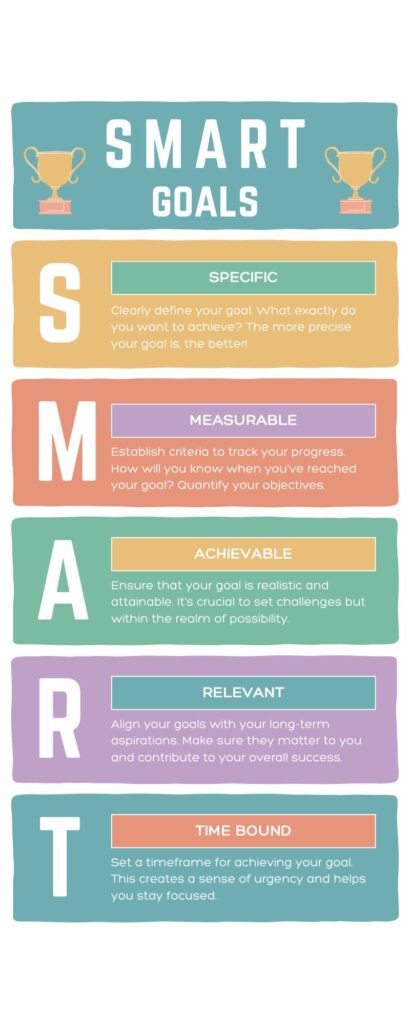We are a professional review company that receives compensation from companies whose products we review. We test each product thoroughly and give high marks only to the ones that are the very best. We are independently owned, and the opinions expressed here are our own.
Setting and achieving personal goals is fundamental for personal growth and success. Goals provide direction, motivate us to take action, and help us measure our progress. Whether you aim to advance your career, improve your health, or learn a new skill, effective goal-setting can turn your aspirations into reality.
Take Sarah, for example. Sarah wanted to run a marathon but struggled to stick to her training plan. By setting clear, actionable goals and breaking them into manageable steps, she completed her first marathon and discovered a newfound passion for running. Sarah’s story illustrates the transformative power of goal-setting.
In this article, we will explore the importance of setting personal goals, how to identify and create achievable goals, and the steps needed to stay motivated and overcome obstacles. We’ll provide practical tips and techniques to help you stay on track and celebrate your successes. Let’s dive into the comprehensive guide on setting and achieving personal goals so that you can turn your dreams into tangible achievements.
Understanding the Importance of Goal-Setting
Setting goals is a powerful tool for driving personal growth and success. By providing a clear direction and a sense of purpose, goals motivate us to take action and measure our progress. Let’s explore why setting goals is essential and the different goals you can set.

Why Set Goals?
Purpose and Direction: Setting goals gives you a clear direction to follow. It helps you define what you want to achieve and create a roadmap. For example, Sarah’s marathon goal provided her with a specific target, guiding her training and preparation.
Motivation: Goals act as a source of motivation by providing you with something to strive for. They can ignite your passion and keep you focused on your desired outcomes. When you set a goal, you are likelier to stay committed and put in the necessary effort to achieve it.
Personal Growth: Goals encourage individual growth and development. As you work towards achieving your goals, you learn new skills, gain knowledge, and build confidence. Achieving goals, no matter how small, can lead to a sense of accomplishment and boost your self-esteem.
Measuring Progress: Goals provide a way to measure your progress. They allow you to track your achievements and see how far you’ve come. This can be incredibly motivating and can help you stay on course. Sarah, for instance, could measure her progress by tracking her running times and distances.
Types of Goals
Short-Term vs. Long-Term Goals:
- Short-Term Goals: You aim to achieve these shortly, typically within a few weeks or months. They are often stepping stones towards more significant, long-term goals. For example, Sarah’s short-term goal might be to run 5 kilometers without stopping.
- Long-term Goals: These goals are set longer, often several months or years. They require sustained effort and commitment. Sarah’s long-term goal was to complete a marathon, which required consistent training over many months.
Personal vs. Professional Goals:
- Personal Goals: These are goals related to your personal life and well-being. They can include health and fitness goals, hobbies, relationships, and personal development. Sarah’s goal to run a marathon improved her fitness and provided a sense of achievement.
- Professional Goals: These goals pertain to your career and professional development. They can include gaining new skills, achieving a promotion, or starting a new business. For example, setting a goal to complete a professional certification can advance your career.
References
For further reading on the importance of goal-setting and types of goals, you can explore the following:
- Psychology Today – The Importance of Setting Goals
- Mind Tools – Personal Goal Setting
- Verywell Mind – How to Set and Achieve Goals
Understanding the importance of goal-setting and the different goals you can set is the first step toward achieving your dreams. In the next section, we will explore how to identify your goals and create a plan to achieve them.

Identifying Your Goals
The first step in setting and achieving personal goals is identifying what you truly want to accomplish. This involves self-reflection, understanding your desires, and applying a structured approach to define your goals clearly. Let’s explore how to identify your goals effectively.
Self-Reflection
Self-reflection is crucial for understanding your deepest desires and aspirations. It helps you clarify what you want to achieve and why it matters.
Importance of Understanding Your Desires and Aspirations:
- It helps you set meaningful goals that resonate with your core values.
- Ensures your goals align with your long-term vision for your life.
Techniques for Self-Reflection:
- Journaling: Write down your thoughts, dreams, and ideas regularly. Reflect on what excites you, what you wish to change, and what you want to achieve. Journaling helps clarify your thoughts and can reveal patterns and passions.
- Meditation: Spend time in quiet meditation to connect with your inner self. Meditation can help clear your mind and focus on your true desires.
- Seeking Feedback: Ask trusted friends, family, or mentors for feedback on your strengths and areas for improvement. Their insights can help you identify potential goals you might not have considered.
SMART Goals Framework
Once you understand what you want to achieve, it’s time to define your goals using the SMART framework. SMART goals are Specific, Measurable, Achievable, Relevant, and Time-bound, making them clear and attainable.
Definition and Importance of SMART Goals:
- Specific: Clearly define what you want to achieve. Particular goals provide a clear direction and focus.
- Measurable: Ensure your goal can be measured so you can track your progress and know when you’ve achieved it.
- Achievable: Set realistic and attainable goals based on your current abilities and resources.
- Relevant: Choose goals that are important to you and align with your broader life objectives.
- Time-bound: Set a deadline for achieving your goal to create a sense of urgency and motivate action.
Examples of Converting Vague Goals into SMART Goals:
- Vague Goal: “I want to get fit.”
- SMART Goal: “I want to lose 10 pounds in 3 months by exercising for 30 minutes five days a week and eating a balanced diet.”
- Vague Goal: “I want to save money.”
- SMART Goal: “I will save $1,000 in 6 months by setting aside $50 from each paycheck and reducing unnecessary expenses.”

References
For further reading on identifying and setting SMART goals, explore:
By self-reflection and applying the SMART framework, you can identify clear and achievable goals. In the next section, we will discuss creating a plan of action to turn your goals into reality.
Creating a Plan of Action
Once you’ve identified your goals and made them SMART, the next step is to create a detailed action plan. This involves breaking down your goals into manageable tasks, prioritizing them, and setting timelines to ensure steady progress.
Breaking Down Goals
Significant goals can seem overwhelming, but breaking them into smaller, manageable tasks makes them more achievable. This process helps maintain motivation and provides a clear path forward.
Importance of Dividing Large Goals into Smaller Tasks:
- Manageability: Smaller tasks are more accessible to tackle and complete, reducing the feeling of being overwhelmed.
- Progress Tracking: Breaking down goals allows you to track progress more effectively, providing a sense of achievement as you complete each task.
- Focus: Smaller tasks help maintain focus on specific actions, making it easier to stay on track.
Steps to Break Down Goals:
- Identify Milestones: Determine key milestones that represent significant progress toward your goal. For example, if your goal is to run a marathon, a milestone could be running a half marathon.
- Create Action Steps: For each milestone, list specific action steps needed to achieve it. For example, to run a marathon, action steps might include following a weekly training plan, joining a running group, and scheduling regular practice runs.
- Set Timelines: Assign timelines to each action step to ensure consistent progress. This could involve setting weekly or monthly deadlines for completing specific tasks.
Prioritizing Goals
Not all tasks are equally important. Prioritizing your tasks helps you focus on what’s most important and ensures that you are making progress toward your most significant goals.
Techniques for Prioritizing:
- Eisenhower Matrix: Categorize tasks into four quadrants based on urgency and importance:
- Urgent and Important: Tasks that need immediate attention.
- Important but Not Urgent: Tasks that are important but can be scheduled.
- Urgent but Not Important: Tasks that should be delegated or minimized.
- Not Urgent and Not Important: Tasks that can be eliminated.
- ABCDE Method: Rank tasks by priority:
- A: Tasks that are very important and must be done.
- B: Tasks that should be done but are not as critical as A tasks.
- C: Tasks that would be nice to do but are not essential.
- D: Tasks that can be delegated to someone else.
- E: Tasks that can be eliminated.
Importance of Focusing on High-Impact Goals:
- Maximize Results: Prioritizing high-impact goals ensures that you focus your time and energy on tasks that yield the most significant results.
- Efficient Use of Time: By concentrating on what’s most important, you avoid wasting time on less critical tasks.
References
For more detailed guidance on breaking down and prioritizing goals, explore:
- Positive Psychology – Goal-Setting Worksheets
- The Goal Chaser – Setting Goals
- Indeed – Tips for Prioritizing Goals
Creating a plan of action by breaking down your goals and prioritizing them is crucial for turning your aspirations into reality. In the next section, we will discuss how to stay motivated and overcome obstacles that may arise on your journey.

Staying Motivated and Overcoming Obstacles
Achieving personal goals requires consistent motivation and the ability to overcome obstacles that may arise along the way. This section explores strategies for maintaining motivation and effectively addressing common challenges.
Maintaining Motivation
Maintaining motivation is crucial for staying committed to your goals. Here are several strategies to keep your motivation high:
Visual Reminders:
- Vision Boards: Create a vision board with images and quotes representing your goals. Place it somewhere you’ll see daily to keep your goals in mind.
- Progress Charts: Use charts or graphs to visualize your progress. Seeing incremental achievements can be highly motivating.
Rewards:
- Small Rewards: Reward yourself for completing smaller tasks and milestones. These rewards can be simple, like treating yourself to your favorite coffee or taking a relaxing bath.
- Major Rewards: Plan a significant reward for achieving your primary goal, such as a weekend getaway or a new gadget you’ve been eyeing.
Accountability Partners:
- Find a Buddy: Share your goals with a friend or family member who can help keep you accountable. Regular check-ins with your accountability partner can provide encouragement and motivation.
- Join a Group: Participate in groups or communities with similar goals. Sharing progress and challenges with others can provide support and inspiration.
Maintaining a Positive Mindset:
- Positive Affirmations: Use positive affirmations to reinforce your commitment and belief in your ability to achieve your goals.
- Reflect on Your Why: Regularly remind yourself why you set the goal in the first place. Connecting with the deeper purpose behind your goals can reignite your motivation.
Overcoming Challenges
Challenges are inevitable, but overcoming them is crucial for staying on track with your goals. Here are some common obstacles and strategies to overcome them:
Procrastination:
- Break Tasks Down: Large tasks can be daunting and lead to procrastination. Break them into smaller, more manageable tasks to make them less intimidating.
- Set Deadlines: Establish clear deadlines for each task to create a sense of urgency and focus.
- Use the Pomodoro Technique: Work in short, focused bursts (e.g., 25 minutes), followed by a short break. This method can help maintain concentration and productivity.
Fear of Failure:
- Embrace Failure as a Learning Opportunity: Understand that failure is part of the learning process. Each setback is an opportunity to learn and grow.
- Visualize Success: Regularly visualize yourself achieving your goal. This positive imagery can build confidence and reduce fear.
- Seek Support: Discuss your fears with a trusted friend, mentor, or therapist who can provide reassurance and advice.
Lack of Resources:
- Identify Necessary Resources: Determine what resources (time, money, skills) you need to achieve your goals and create a plan to acquire them.
- Seek Alternatives: If specific resources are unavailable, find alternative ways to achieve your goals. For example, consider taking a free online course if you need a particular skill.
- Network: Leverage your network to find resources, advice, and support. Sometimes, others can offer assistance or point you in the right direction.
References
For more detailed strategies on staying motivated and overcoming obstacles, explore:
- James Clear – How to Stay Motivated
- Psychology Today – Overcoming Procrastination
- Mind Tools – How to Stop Procrastinating
By implementing these strategies, you can maintain your motivation and effectively overcome obstacles, ensuring steady progress toward your goals. In the next section, we will discuss tracking your progress and making necessary adjustments to stay on course.

Tracking Progress and Adjusting Goals
Consistently tracking your progress and being flexible enough to adjust your goals as needed are crucial steps in achieving personal goals. This section covers monitoring your progress and making necessary adjustments to stay on track.
Monitoring Progress
Regularly monitoring your progress allows you to see how far you’ve come and identify any areas needing more focus. It also helps maintain motivation by highlighting your achievements along the way.
Importance of Regularly Reviewing Progress:
- Accountability: Regular check-ins keep you accountable to your goals.
- Motivation: Seeing progress can boost your motivation and encourage continued effort.
- Adjustment: Identifying what’s working and what’s not allows for timely adjustments.
Tools and Techniques for Tracking:
- Journals: Keeping a journal to document your daily or weekly progress can help you reflect on your journey. Write down what you accomplished, any challenges you faced, and how you overcame them.
- Apps: Utilize goal-tracking apps like Trello, Asana, or Habitica to monitor your progress. These apps often provide visual progress charts and reminders to help keep you on track.
- Progress Charts: Create visual charts to track your progress. For example, Sarah could use a running log to track her weekly mileage and see her improvements over time.
Adapting and Adjusting Goals
Sometimes, despite your best efforts, circumstances change, and your original goals may need to be adjusted. Flexibility is key to ensuring that your goals remain relevant and achievable.
Recognizing When to Adjust Goals:
- Unforeseen Challenges: Life events or obstacles that were not anticipated may require goal adjustments.
- Feedback and Results: If progress is slower than expected or feedback suggests a different approach, it may be time to reassess your goals.
- Changing Priorities: As you grow and evolve, your priorities might change, necessitating a shift in your goals.
Techniques for Making Necessary Adjustments:
- Reevaluate Goals: Review your goals to ensure they align with your vision and circumstances. If needed, redefine them to match your current situation better.
- Modify Timelines: If the original deadlines are unrealistic, adjust your timelines. Allow yourself more time to achieve your goals without feeling rushed or stressed.
- Adjust Action Steps: If specific actions are not yielding the desired results, consider changing your approach. For instance, if Sarah finds her current training plan too intense, she might opt for a more gradual increase in mileage.
References
For more detailed strategies on tracking progress and adjusting goals, explore:
- Indeed – How to Track Your Progress
- Verywell Mind – The Importance of Setting Goals
- Mind Tools – Personal Goal Setting
Tracking your progress and being open to adjusting your goals when necessary is crucial for staying on course and achieving your personal goals. Regularly reviewing your progress and making informed adjustments can ensure your efforts remain focused and effective. The following section will explore the importance of celebrating your achievements and learning from your experiences.

Celebrating Achievements
Celebrating your achievements is a crucial step in the goal-setting process. Recognizing and rewarding your progress boosts motivation and reinforces the behaviors that lead to success. This section discusses the importance of celebrating milestones and provides practical ways to celebrate your achievements.
Recognizing Success
Acknowledging your accomplishments, no matter how small, can significantly impact your motivation and self-esteem.
Importance of Celebrating Milestones and Achievements:
- Boosts Motivation: Celebrations create a positive feedback loop, encouraging you to strive towards your goals.
- Builds Confidence: Recognizing your progress helps build self-confidence and reinforces your belief in your abilities.
- Enhances Well-Being: Celebrating successes can increase your overall sense of happiness and satisfaction.
Ways to Celebrate:
- Personal Rewards: Treat yourself to something special when you reach a milestone. This could be a favorite meal, a day off, or a small gift.
- Sharing Success with Others: Share your achievements with friends, family, or a support group. Their recognition and encouragement can amplify your sense of accomplishment.
- Reflecting on Progress: Take time to reflect on your journey. Write about your achievements in a journal, noting what you did well and how you overcame challenges.
Learning from Experience
Analyzing your journey and learning from your experiences, both successes and setbacks is essential for continuous improvement.
Analyzing What Worked and What Didn’t:
- Review Strategies: Reflect on the strategies and actions that led to success. Identify what worked well and why.
- Identify Challenges: Consider the obstacles you faced and how you overcame them. Understanding these challenges can help you prepare for future goals.
Using Insights to Set Future Goals:
- Adjust Approaches: Use the insights gained from your experiences to refine your goal-setting and action plans. For instance, if Sarah found that running with a group helped her stay motivated, she might incorporate group activities into future fitness goals.
- Set New Goals: Build on your successes by setting new, more challenging goals. Continuous goal-setting keeps you focused on personal growth and development.
References
For more detailed guidance on celebrating achievements and learning from experiences, explore:
- Psychology Today – The Importance of Celebrating Success
- Verywell Mind – How to Celebrate Your Wins in a Healthy Way
- Mind Tools – Celebrating Success
By celebrating your achievements and reflecting on your experiences, you can maintain motivation and continue growing. Recognizing your successes reinforces positive behaviors and helps you learn valuable lessons that can be applied to future goals.

Conclusion
Setting and achieving personal goals is a transformative process that can significantly enhance your personal and professional life. You can turn your aspirations into reality by understanding the importance of goal-setting, identifying your goals, creating a plan of action, staying motivated, overcoming obstacles, and celebrating your achievements.
Recap of Key Points Discussed:
- Understanding the Importance of Goal-Setting: Setting goals provides direction, motivation, and a sense of purpose. It also allows you to measure your progress and fosters personal growth.
- Identifying Your Goals: Self-reflection and using the SMART goals framework can help you set clear, achievable goals that align with your desires and aspirations.
- Creating a Plan of Action: Breaking down your goals into manageable tasks and prioritizing them ensures steady progress and helps maintain focus.
- Staying Motivated and Overcoming Obstacles: Maintaining motivation through visual reminders, rewards, and accountability partners and addressing common challenges like procrastination and fear of failure are crucial for goal achievement.
- Tracking Progress and Adjusting Goals: Regularly reviewing your progress and being flexible enough to adjust your goals ensures that you stay on track and achieve your objectives.
- Celebrating Achievements: Recognizing and celebrating your successes boosts motivation, builds confidence, and enhances well-being. Reflecting on your experiences allows you to learn and improve for future goal-setting.
Encouragement
Achieving your personal goals is a journey that requires dedication, persistence, and a positive mindset. Each small step you take toward your goals brings you closer to realizing your dreams. Remember that setbacks are a natural process and provide valuable learning opportunities. Stay focused, stay motivated, and keep moving forward.
What’s Your Next Step?
Start today by setting a new goal or reevaluating an existing one. Use the strategies and techniques discussed in this guide to create a plan and take the first step toward achieving your goals. Share your progress with friends, family, or an online community to stay accountable and motivated. Explore the resources below for more tips and insights on personal development and goal-setting.
Additional Resources
Explore more articles and resources on goal-setting and personal development:
- Psychology Today – The Importance of Setting Goals
- Mind Tools – Personal Goal Setting
- Verywell Mind-Setting and Achieving Goals
By embracing these strategies and utilizing available resources, you can successfully set and achieve your personal goals, leading to a more fulfilling and accomplished life.
To your success,




What do you think about the article you've just read? Please tell me below.